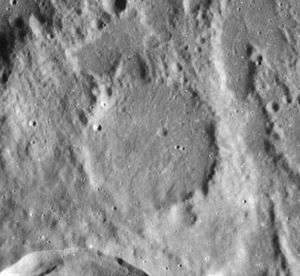Spörer (crater)
 Lunar Orbiter 4 image | |
| Coordinates | 4°18′S 1°48′E / 4.3°S 1.8°ECoordinates: 4°18′S 1°48′E / 4.3°S 1.8°E |
|---|---|
| Diameter | 27 km |
| Depth | 0.3 km |
| Colongitude | 2° at sunrise |
| Eponym | Friedrich W. G. Spörer |
Spörer is a lunar impact crater that lies just about 10 km north of the crater Herschel, and southeast of the lava-flooded Flammarion. About 40 km southeast is Gyldén, and over 60 km northeast is Réaumur.
Its diameter is 27 km long and is about 300 meters deep. Also, the area is around 400 km² and the perimeter is around 75 km.
The crater is named after Gustav Spörer.[1]
The floor of this crater has been flooded with basaltic lava, leaving only a shallow rim above the surface. The narrow rim is roughly circular but irregular and broken in several locations. The rim has a slight outward bulge to the northwest. The interior of the crater is level and featureless.
Satellite craters

By convention these features are identified on lunar maps by placing the letter on the side of the crater midpoint that is closest to Spörer. Only one lettered satellite crater is founded and is located to the north and is known as Spörer A.
| Spörer | Latitude | Longitude | Diameter |
|---|---|---|---|
| A | 3.4° S | 2.1° W | 5 km |
Notes
- ↑ "Spörer". Gazeteer of Planetary Nomenclature. International Astronomical Union. Retrieved 18 August 2017.
References
- Andersson, L. E.; Whitaker, E. A. (1982). NASA Catalogue of Lunar Nomenclature. NASA RP-1097.
- Blue, Jennifer (July 25, 2007). "Gazetteer of Planetary Nomenclature". USGS. Retrieved 2007-08-05.
- Bussey, B.; Spudis, P. (2004). The Clementine Atlas of the Moon. New York: Cambridge University Press. ISBN 978-0-521-81528-4.
- Cocks, Elijah E.; Cocks, Josiah C. (1995). Who's Who on the Moon: A Biographical Dictionary of Lunar Nomenclature. Tudor Publishers. ISBN 978-0-936389-27-1.
- McDowell, Jonathan (July 15, 2007). "Lunar Nomenclature". Jonathan's Space Report. Retrieved 2007-10-24.
- Menzel, D. H.; Minnaert, M.; Levin, B.; Dollfus, A.; Bell, B. (1971). "Report on Lunar Nomenclature by the Working Group of Commission 17 of the IAU". Space Science Reviews. 12 (2): 136–186. Bibcode:1971SSRv...12..136M. doi:10.1007/BF00171763.
- Moore, Patrick (2001). On the Moon. Sterling Publishing Co. ISBN 978-0-304-35469-6.
- Price, Fred W. (1988). The Moon Observer's Handbook. Cambridge University Press. ISBN 978-0-521-33500-3.
- Rükl, Antonín (1990). Atlas of the Moon. Kalmbach Books. ISBN 978-0-913135-17-4.
- Webb, Rev. T. W. (1962). Celestial Objects for Common Telescopes (6th revised ed.). Dover. ISBN 978-0-486-20917-3.
- Whitaker, Ewen A. (1999). Mapping and Naming the Moon. Cambridge University Press. ISBN 978-0-521-62248-6.
- Wlasuk, Peter T. (2000). Observing the Moon. Springer. ISBN 978-1-85233-193-1.
External links
| Wikimedia Commons has media related to Sporer (crater). |
- Spörer at the Moon Wiki